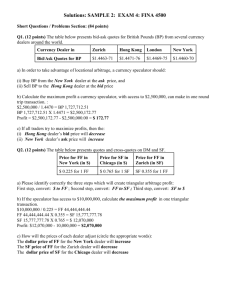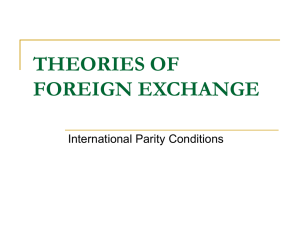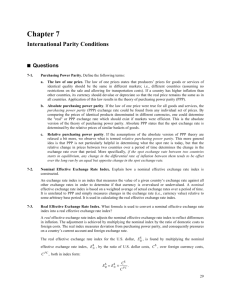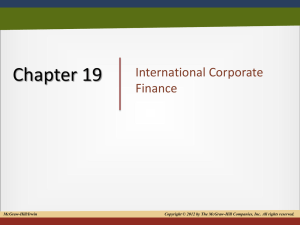Ch07 - NTU
advertisement
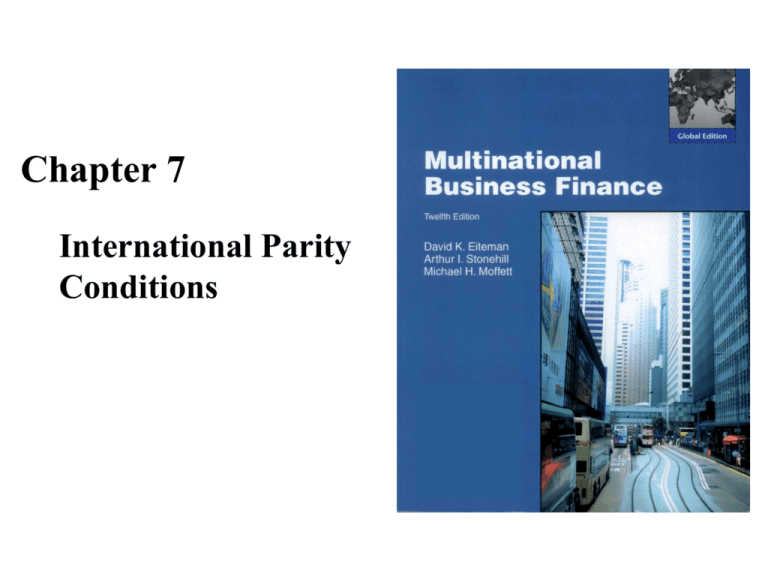
Chapter 7 International Parity Conditions The Goals of Chapter 7 • Describes the core financial theories surrounding the determination of exchange rates (Chapter 10 will further introduce two other models regarding the currency valuation) • More specifically, four international parity conditions will be introduced among the exchanges rates, price levels, and interest rates – – – – Purchasing power parity Fisher effect International Fisher effect Interest rate parity • Introduce the relationship between the (future) spot exchange rate and the forward exchange rate 7-2 International Parity Conditions • Some fundamental questions that managers of MNEs, international portfolio investors, importers, exporters, and government officials must deal with every day are: – What are the determinants of exchange rates? – Are changes in exchange rates predictable? • The financial theories that link exchange rates, price levels, and interest rates together are called international parity conditions • These theories do not always work out to be “true” when compared to what you observe in the real world, but they are still fundamental to understand exchange rates and thus the risk of international investments – The mistake is sometimes not with the theory itself, but in the way it is interpreted or applied in practice 7-3 Price Levels and Exchange Rates 7-4 Price Levels and Exchange Rates • If the identical product or service can be: – Sold in two different markets (perfect substitutability of goods and services) – No restrictions exist on the sale (free trade) – No transportation costs of moving the product between markets (costless transportation) ※Then the product or service prices should be the same in both markets • In a word, perfectly tradable goods or services are subject to the law of one price • A primary principle of competitively efficient markets is that prices of identical products or services will equalize across them if frictions or transportation costs do not exist 7-5 Price Levels and Exchange Rates • If the two markets are in two different countries, the product’s price may be stated in different currency terms – Price comparison in different markets (countries) would require a conversion from one currency to the other, e.g., P$ ? × S = P¥ where the product price in US dollars is P$, the spot exchange rate is S (yen per US$), and the price in Japanese yen is P¥ • If these two markets are competitively efficient, i.e., the law of one price holds, the purchasing power parity (PPP) exchange rate could be deduced from the relative local product prices: S = P¥ / P$ – If the price level in the U.S. P$ ↑, then S ↓, which means that the US$ depreciates 7-6 Price Levels and Exchange Rates • The absolute version of the PPP theory – By comparing the prices of identical products denominated in different competitively efficient currencies, we could determine the PPP exchange rate • The hamburger standard or said the Big Mac index is calculated regularly by The Economist since 1986 Country U.S. Euro area Big Mac price in US$ Implied PPP exchange rate Under (-) / over(+) valuation (FC vs. US$) relative to the Big Mac index $3.57 – – $5.34 = €3.37×$1.5846/€ $1.0593/€ =$3.57/€3.37 +49.58% =($1.5846/€ - $1.0593/€) / $1.0593/€ ※ A Big Mac in the Euro area cost €2.92, and the actual exchange rate is $1.5846/€ ※ An alternative to the hamburger standard is the “Starbucks tall-latte index” introduced by The Economist in 2004 7-7 Price Levels and Exchange Rates • Why is the Big Mac a good candidate for the application of the law of one price? – The product is nearly identical in each market – The product is a result of predominantly local materials and input costs, i.e., its price in each country represents domestic costs and prices rather than imported ones • Only a price of single product is not objective enough to decide the exchange rate – Replacing the price of a single product with a price index of a basket of goods, the absolute PPP exchange rate between two countries can be stated as S = PI¥ / PI$ 7-8 Price Levels and Exchange Rates • Based on the absolute version of the PPP theory, we can derive relative purchasing power parity (RPPP) • RPPP is not particularly helpful in determining what the spot exchange rate today, but that the relative change in prices between two countries over a period of time determines the change in the exchange rate over that period • More specifically, the spot exchange rate should change in an equal amount but in the opposite direction to the difference in inflation rates between two countries – Thus, the currency with higher (lower) inflation rate will depreciate (appreciate) 7-9 Price Levels and Exchange Rates • Given the exchange rate St = Pt¥ / Pt$ (yen per US$) at time t, Pt¥(1 ¥) (1 ¥) St+1 $ St $ Pt (1 ) (1 $ ) • For the indirection quotation of Japanese ¥ for the U.S., the change of the exchange rate is as follows (see Slide 6-37) St St+1 St+1 (1 ¥) St St (1 $ ) (1 $ ) (1 ¥) (1 ¥) 1 ¥ St (1 $ ) St St+1 (1 $ ) (1 ¥) $ ¥ St+1 +: FC appreciates against DC –: FC depreciates against DC ※ If π¥ is smaller than π$ (the U.S. is with a higher inflation rate), St+1 is smaller than St, which indicates the appreciation of Japanese ¥ (depreciation of US$) ※ Furthermore, the percentage change of the PPP exchange rate is proportional to 7-10 the difference of the inflation rate (see Exhibit 7.2 on the next slide) Exhibit 7.2 Relative Purchasing Power Parity (RPPP) ※ For instance, point P represents an equilibrium point where the inflation rate in the foreign country, Japan, is 4% lower than that in the home country, the U.S. ※ Therefore, RPPP would predict that the Japanese yen would appreciate by 4% per annum with respect to the U.S. dollars ※ If the domestic country is with a higher inflation rate prices of domestic products become relatively expensive export ↓, import ↑ deficit on current account (and on BOP) supply of domestic currency > demand of domestic currency domestic currency depreciates 1-11 Price Levels and Exchange Rates • Empirical testing of PPP and the law of one price has been done, but has not proved PPP to be accurate in predicting future exchange rates • Possible reasons for the poor performance of PPP – Transportation costs of goods and services are not zero – Many services are not tradable, e.g., legal services – Many goods and services are not of the same quality across countries, reflecting different tastes of consumers in different countries – Different tax rules in different countries 7-12 Price Levels and Exchange Rates • Two general conclusions from these studies: – PPP or RPPP hold well over the very long run but poorly for shorter time periods – The theory holds better for countries with relatively high rates of inflation and underdeveloped capital markets • A higher inflation rate generates a strong enough pressure to affect the currency to depreciate • For countries with underdeveloped capital markets, the effect of the current account dominates BOP (comparing to the financial and capital accounts), so there is a closer relationship between price levels and exchange rates 7-13 Nominal and Real Exchange Rates • According to the RPPP, the change of the (nominal) exchange rate is to offset the change in the differential growths of price levels between two countries – For the country with a higher inflation rate, the prices of products increase inside the country, but due to the depreciation of the currency of that country, the prices of products in foreign currency remain the same • So, the change of the nominal exchange rate will not affect the relatively competitive power for different countries • Only the change of the real exchange rate, which measures the purchasing power of a currency, will affect the price competitiveness of a country 7-14 Nominal and Real Exchange Rates • The real exchange rate is defined as follows SR,t = SN,t Pf,t Pd,t – SR,t: real exchange rate at time t – SN,t: nominal exchange rate at time t (1 foreign dollar = SN,t domestic dollars) – Pf,t: foreign price level at time t relative to the base period at time 0 (Pf,0=100) – Pd,t: domestic price level at time t relative to the base period at time 0 (Pd,0=100) ※ If RPPP holds, the magnitude of the increase of the foreign price level (Pf,t ↑) and the magnitude of the depreciation of the foreign currency (SN,t ↓) will be the same and offset for each other, so the real exchange rate will not change 7-15 Nominal and Real Effective Exchange Rate Indices • Individual national currencies often need to be evaluated against all other currency values to determine relative purchasing power • The objective is to discover whether a nation’s exchange rate is “overvalued” or “undervalued” in terms of PPP • This problem is often dealt with through the calculation of exchange rate indices such as the nominal effective exchange rate index and the real effective exchange rate index 7-16 Nominal and Real Effective Exchange Rate Indices • Nominal effective exchange rate index (NEERI) uses nominal exchange rates to create an index, on a weighted average basis, of the value of the main trading currencies over a period of time, which is defined as follows n (1/SN,i,t ) i=1 (1/SN,i,0 ) NEERI t = Wi ( 100) – n: number of major trading currencies for the domestic country – Wi: weight of a foreign currency, depending on the trading volume between the domestic country and that foreign country – SN,i,t: nominal exchange rates for the i-th foreign currency at time t (1/SN,i,t measures the domestic currency value in terms of foreign currencies) 7-17 Nominal and Real Effective Exchange Rate Indices • Example to calculate NEERI for NT$ against the US$ and Japanese yen (Year 2000 is the base period) SN,i,2000 SN,i,2008 Trading volume U.S. (i=1) 1US$=30NT$ 1US$=32NT$ NT$ 600 billion Japan (i=2) 1¥=0.25NT$ 1¥=0.2NT$ NT$ 400 billion NEERI2000 =W1 ( (1/SN,1,2000 ) (1/SN,1,2000 ) 100) W2 ( (1/SN,2,2000 ) (1/SN,2,2000 ) 100) (1/30) (1/0.25) 100) 0.4 ( 100) 100 (1/30) (1/0.25) (1/SN,1,2008 ) (1/SN,2,2008 ) NEERI2008 =W1 ( 100) W2 ( 100) (1/SN,1,2000 ) (1/SN,2,2000 ) 0.6 ( 0.6 ( (1/32) (1/0.2) 100) 0.4 ( 100) 106.25 (1/30) (1/0.25) ※ From 2000 to 2008, NT$ depreciates against US$ (by 6.3%) and appreciates against Japanese ¥ (by 25%) ※ From the analysis of NEERI, overall speaking, the nominal exchange rate of NT$ appreciates by 6.25% against the US$ and Japanese ¥ 7-18 Nominal and Real Effective Exchange Rate Indices • Real effective exchange rate index (REERI) indicates how the weighted average purchasing power of the domestic currency has changed relative to some arbitrarily selected base period, which is defined as follows n (1/SR,i,t ) i=1 (1/SR,i,0 ) REERI t = Wi ( 100) – SR,i,t: real exchange rates for the i-th foreign currency at time t 7-19 Nominal and Real Effective Exchange Rate Indices • Example to calculate REERI for NT$ against the US$ and Japanese yen (Year 2000 is the base period) U.S. (i=1) SN,i,2000 SN,i,2008 Price level in 2000 Price level in 2008 Trading volume 1US$=30NT$ 1US$=32NT$ 100 125 NT$ 600 billion 1¥=0.2NT$ 100 95 NT$ 400 billion 100 110 Japan (i=2) 1¥=0.25NT$ Taiwan SR,1,2000 = SN,1,2000 SR,2,2000 =SN,2,2000 Pd,2000 Pf,2,2000 Pd,2000 SR,1,2008 = SN,1,2008 SR,2,2008 =SN,2,2008 Pf,1,2000 Pf,1,2008 Pd,2008 Pf,2,2008 Pd,2008 =30 100 30 100 =0.25 =32 100 0.25 100 125 36.3636 110 =0.20 95 0.1727 110 Pf,t SR,t = SN,t Pd,t on Slide7-15 7-20 Nominal and Real Effective Exchange Rate Indices REERI2000 =W1 ( (1/SR,1,2000 ) (1/SR,1,2000 ) 100) W2 ( (1/SR,2,2000 ) (1/SR,2,2000 ) 100) (1/30) (1/0.25) 100) 0.4 ( 100) 100 (1/30) (1/0.25) (1/SR,1,2008 ) (1/SR,2,2008 ) REERI 2008 =W1 ( 100) W2 ( 100) (1/SR,1,2000 ) (1/SR,2,2000 ) 0.6 ( 0.6 ( (1/36.3636) (1/0.1727) 100) 0.4 ( 100) 107.40 (1/30) (1/0.25) ※ Overall speaking, the real exchange rate of NT$ appreciates by 7.40% against the US$ and Japanese ¥ ※ In other words, the purchasing power of NT$ increases by 7.40% against the US$ and Japanese ¥ from 2000 to 2008 7-21 Nominal and Real Effective Exchange Rate Indices • The meaning of real effective exchange rate index (REERI): – REERIt > REERI0: Real exchange rate of the domestic currency against foreign currencies appreciates relative to the base period, so the competitive power of domestic products decreases relative to the base period – REERIt < REERI0: Real exchange rate of the domestic currency against foreign currencies depreciates relative to the base period, so the competitive power of domestic products increases relative to the base period 7-22 Exhibit 7.3 Real Effective Exchange Rate Indexes for Some Selected Currencies (Y2000 = 100) ※ From 1981 to 1995, the real exchange rate of Japanese ¥ against foreign currencies appreciates, so the competitive power of the Japanese products declines ※ From 1995 to 2008, the real exchange rate of Japanese ¥ against foreign currencies depreciates generally, so the competitive power of the Japanese products increases ※ If the RPPP is true for the long term, i.e., the real exchange rate remains stable due to the offset of the effects of the changes in nominal exchange rates and inflation rates, the REERI should fluctuate around 100 7-23 Exchange Rate Pass-Through • The degree to which the prices of imported and exported goods change as a result of exchange rate changes is termed exchange rate pass-through • Although PPP implies that all exchange rate changes are passed through by equivalent changes in prices to trading partners, empirical researches in the 1980s questioned this long-held assumption • For example, a car manufacturer may or may not adjust pricing of its cars sold in a foreign country if exchange rates alter the manufacturer’s cost structure in comparison to the foreign market • Pass-through can also be partial as there are many mechanisms by which companies can absorb the impact of exchange rate changes 7-24 Exchange Rate Pass-Through ※The reason for absorption is trying not to affect the selling volume too much ※The absorption could result from reducing profit margins, cost reductions, or both ※Cost reductions arises from the lower imported price for components and raw materials to Germany when the euro appreciates 7-25 Interest Rates and Exchange Rates 7-26 Interest Rates and Exchange Rates • The Fisher effect states that nominal interest rates in each country are equal to the required real rate of return plus compensation for expected inflation • Because investors concern about the real returns (i.e., the growth of their purchasing power), we would expect that as inflation increases, investors will demand higher nominal rates of returns on their investment • The nominal interest rate is derived from (1+r) × (1+ π) – 1, and can be reduced to: i = r + π + rπ r + π where i = nominal interest rate, r = real interest rate, and π = expected inflation 7-27 Interest Rates and Exchange Rates • Because of the arbitrage investment activities among countries, the real interest rates were to be held constant among countries, e.g., if the r$ is larger than the r¥, the capital will flow from Japan to the U.S. continuously until the r$ equals the r¥ • So, according to the Fisher effect, the nominal interest rate and the inflation rate have to be adjusted on a one-for-one basis • Empirical tests using ex post national inflation rates and the nominal rates of return of fixed-income securities have shown the Fisher effect usually exists for short-maturity government securities (see the next slide) 7-28 Interest Rates and Exchange Rates ※ According to the above figure, it is obvious that investors indeed require higher nominal risk-free rates (T-bill rates) with the increase of higher inflation rates ※However, studies about longer-term government bonds and private sector bonds do not support the Fisher effect 7-29 Interest Rates and Exchange Rates • The relationship between the percentage change in the spot exchange rate over time and the differential between comparable interest rates in different national capital markets is known as the international Fisher effect • Fisher found that the spot exchange rate should change in an equal amount but in the opposite direction to the difference in interest rates between two countries – The opposite direction means for a country with lower (higher) interest rates, its currency will appreciate (depreciate) 7-30 Interest Rates and Exchange Rates • The equation of the international Fisher effect: $) – (1+i¥) St St+1 i$ – i¥ (1+i $ – i¥ i St+1 1 + i¥ 1 + i¥ where i$ and i¥ are the respective nominal interest rates of the investing period, and St and St+1 are the spot exchange rates using indirect quotes at the beginning and the end of that period (¥/$) (if St+1 < St, it means that the Japanese ¥ appreciates) • According to the above equation, the currency with lower interest rate will appreciate – If i$ =6% and i¥ =4%, St+1 is expected to be smaller than St by 2%, which means that the Japanese ¥ should appreciate about 2% per year 7-31 Interest Rates and Exchange Rates • The unrestricted capital flows will see the opportunity around the world and make the international Fisher effect to be true • For example, if i$ =6% and i¥ =5%, and the Japanese ¥ is expected to appreciate 2%, the unrestricted capital will flow from the U.S. to Japan to earn 7% (=5% + 2%) return. This activity will increase the money supply in the Japanese economy and thus reduce the i¥ until it becomes 4% (thus the international Fisher effect holds again) 7-32 Interest Rates and Exchange Rates • The international Fisher effect (on Slide 7-31) vs. the Relative Purchase Power Parity (RPPP) (on Slide 7-10) St St+1 $ ¥ i i (r $ $ ) (r ¥ ¥ ) St+1 $ ¥ By force of the international arbitrage, real rates of return between markets should be equal, i.e., r$=r¥ ※ The international Fisher effect and the RPPP is consistent if the Fisher effect is valid ※ The only difference is that in the international Fisher effect, the interest rate, i, is applied to a future time period and thus the inflation rate, π, is the expected inflation rate ※ In the RPPP, however, the inflation rate, π, is ex post, i.e., only at the end of the period, the inflation rate for that period is known, and thus the exchange rate should change in response to the realized inflation rate 7-33 Interest Rates and Exchange Rates • A forward (exchange) rate is an exchange rate quoted today for settlement at some future date • A forward exchange agreement between currencies states the exchange rate at which a foreign currency will be bought forward or sold forward on a specific date in the future • As to the theoretical value for the forward exchange rate of any specific maturity, it is calculated by adjusting the current spot exchange rate by the ratio of interest rates of the same maturity for the two currencies (see the equation on the next slide) 7-34 Interest Rates and Exchange Rates • For example, the 90-day forward rate for the Swiss franc/US dollar exchange rate (F90SF/$ ) is found by multiplying the current spot rate ( SSF/$) by the ratio of the 90-day Swiss franc deposit rate (iSF) over the 90day dollar deposit rate (i$) • The formula for the forward exchange rate (Exhibit 7.6): F90SF/$ 90 1 iSF 360 SF/$ S (indirect quotation for the U.S.) $ 90 1 i 360 $ 90 1 i 360 $/SF $/SF F90 S (direct quotation for the U.S.) SF 90 1 i 360 7-35 Exhibit 7.6 Interest Rate Parity (IRP) Start $1,000,000 i $ = 8.00 % per annum (2.00 % for 90 days) x 1.02 End $1,020,000 Dollar money market S = SF1.4800/$ 90 days F90 is derived to be SF1.4655/$ Swiss franc money market SF 1,480,000 x 1.01 SF 1,494,800 i SF = 4.00 % per annum (1.00 % for 90 days) 90 SF 90 1 SF/$ P 1 i$ P S 1 i SF/$ 360 360 F90 ※ Later, I will show that if F90 deviates from SF1.4655/$, it is possible to design an arbitrage strategy (covered interest arbitrage) to make profit for sure 7-36 Interest Rates and Exchange Rates • The theory of Interest Rate Parity (IRP) provides the link between the foreign exchange markets and the international money markets • The theory states that the difference in the national interest rates should be equal to, but opposite in sign to, the forward rate premium or discount for the foreign currency, except for transaction costs – In the example on the previous slide, the difference between iSF and i$ is –4% per annum – The forward premium for the Swiss Franc against the US$ is +3.96% (+4%) per annum (see the next slide) ※ The above opposite but the-same-magnitude numbers demonstrate the theory of the interest rate parity ※For the currency with the lower interest rate (SF in the above example), its forward exchange rate is at a premium, which implies a pressure to appreciate for that currency 7-37 Interest Rates and Exchange Rates • The forward premium or discount is the percentage difference between the spot and forward exchange rate, stated in annual percentage terms Spot Forward 360 100% Forward n days SF1.4800 / $ SF1.4655/$ 360 100% 3.96% per annum SF1.4655/$ 90 f SF – This is the case when the indirect quotation of the Swiss Franc for the U.S., SF/$, is used – Please refer to Slide 6-36 for the calculation of forward premium or discount for the direct or the indirect quotations 7-38 Interest Rates and Exchange Rates • The spot and forward exchange rates are determined by the demand and the supply and are not constantly in the state of equilibrium described by the interest rate parity (IRP) – When the market is not in equilibrium, the potential for “risk-less” or arbitrage profit exists – The arbitrager will exploit the imbalance by investing in whichever currency offers the higher return on a covered basis – This arbitrage strategy is known as covered interest arbitrage (CIA) (see the example on Exhibit 7.7) – So, the relation between the spot exchange rate and the forward exchange cannot derivate from the IRP too much 7-39 Exhibit 7.7 Covered Interest Arbitrage (CIA) Steps at the beginning of the period: 1. Borrow $1,000,000 2. Convert it into ¥106,000,000 at the spot exchange rate and deposit the proceeds in yen money market to earn 4% return per annum 3. Sell the forward of ¥108,120,000 for dollars at the 180-day forward exchange rate of ¥103.50/$ 1-40 Interest Rates and Exchange Rates • Until the IRP holds again, the arbitrage strategy will – – – – Increase the dollar interest rate Japanese ¥ appreciates (lower S) Lower the yen interest rate Due to the continuous selling yen forward, and thus yen is inclined to depreciate after 180 days (increase F180) ※It is obvious that the arbitrage opportunity becomes thinner and thinner • Arbitrage rule of thumb – If the difference in interest rates is greater (less) than the forward premium, borrow the lower (higher) interest rate currency and invest in the higher (lower) interest rate currency ※For example, in the above case, the forward premium is 4.8309%, which is larger than the difference in interest rates (4%), so borrow US$ and invest in Japanese ¥ 7-41 Interest Rates and Exchange Rates • A deviation from covered interest arbitrage is uncovered interest arbitrage (UIA) • In this case, investors borrow in currencies exhibiting relatively low interest rates and convert the proceeds into currencies that offer much higher interest rates (to earn the interest rate spread) • The transaction is “uncovered” because the investor does not sell the higher yielding currency proceeds forward, choosing to remain uncovered and accept the currency risk of exchanging the higher yield currency into the lower yielding currency at the end of the period – According to the international Fisher effect, however, the higher yield currency is inclined to depreciate 7-42 Exhibit 7.8 Uncovered Interest Arbitrage (UIA): The Yen Carry Trade ※ In the yen carry trade, the investor borrows Japanese yen at relatively low interest rates, converts the proceeds to another currency such as the U.S. dollar where the funds are invested at a higher interest rate for a term. At the end of the period, the investor exchanges the dollars back to yen to repay the loan, pocketing the difference as arbitrage profit. If the spot rate at the end of the period is roughly the same as at the start, or the yen has fallen in value against the dollar, the investor profits. If, however, the US$ were to depreciate versus the Japanese ¥ over that period, the UIA strategy may result in significant loss1-43 Spot Exchange Rates and Forward Exchange Rates 5-44 Spot Exchange Rates and Forward Exchange Rates • Some forecasters believe that forward exchange rates are unbiased predictors of future spot exchange rates • Intuitively this means that the distribution of possible spot exchange rates in the future is centered on the forward exchange rate • Unbiased prediction simply means that the forward exchange rate will, on average, overestimate and underestimate the actual future spot exchange rate in equal frequency and degree • In fact, however, the forward rate usually does not equal the future spot rate 7-45 Exhibit 7.10 Forward Exchange Rate as an Unbiased Predictor for Future Spot Exchange Rate Exchange rate t1 t2 t3 t4 F2,3 S2 S1 Error Error F1,2 F3,4 Error S3 S4 t1 t2 t3 t4 Time ※The forward exchange rate (Ft,t+1), which is decided at time t for delivery at future time t+1, is used as a “predictor” of the future spot exchange rate at the future time point t+1. Therefore, the forecast spot exchange rate for time t2 is F1,2; the actual spot exchange rate turns out to be S2. The vertical distance between the prediction and the actual spot exchange rate is the forecast error ※When the forward exchange rate is termed an “unbiased predictor of the future spot exchange rate,” it just means that the forward rate over- or under-estimates the future spot exchange rate with relatively equal frequency and amount. It therefore “misses the 1-46 mark” in a regular and orderly manner, but the sum of the errors equals zero Spot Exchange Rates and Forward Exchange Rates • Empirical studies, based on the long-term data, analyze the foreign exchange markets and suggest that the forward exchange rate is NOT an unbiased predictor of the future spot exchange rate • Furthermore, the existence and success of foreign exchange forecasting services in the real world imply that managers are willing to pay a price for forecast information even though they can use the forward exchange rate as a forecast at no cost • The above fact further proves that it is difficult to predict future spot exchange rate using only the information of the forward exchange rate 7-47 Summary 5-48 Exhibit 7.11 International Parity Conditions in Equilibrium (Approximate Form) ※ The forecasted inflation rates for Japan and the U.S. are 1% and 5%, respectively ※ The nominal interest rates for Japan and the U.S. are 4% and 8%, respectively ※ The spot exchange rate, S1, is ¥104/$, one-year forward exchange rate is ¥100/$, and the expected change of the spot exchange rate is 4% (yen strengthens) Forward exchange rateas an unbiased predictor (E) Forward premium on foreign currency +4 % (yen strengthens) Interest rate parity (D) Forecast change in spot exchange rate +4 % (yen strengthens) International Fisher effect (C) Difference in nominal interest rates –4 % (less in Japan) Relative purchasing power parity (A) Forecast difference in rates of inflation –4 % (less in Japan) Fisher effect (B) 1-49 Interest Rates and Exchange Rates • Relation (A) (RPPP): the currency with lower inflation rate will appreciate, and the magnitude of the difference of inflation rates (–4%) and the change of the spot exchange rate are the same (4%) • Relation (B) (Fisher effect): the real interest rates were to be held constant among countries, and the nominal interest rate and the inflation rate have to be adjusted on a one-for-one basis – For both the U.S. and Japan, the real interest rates are 3%, and the difference of nominal interest rates (8% –4%=4%) results from the difference of inflation rates (5% –1%=4%) • Relation (C) (International Fisher effect): spot exchange rate should change (+4%) in an equal amount but in the opposite direction to the difference in interest rates (–4%) 7-50 Interest Rates and Exchange Rates • Relation (D) (IRP): for the currency with the lower interest rate, its forward exchange rate is at a premium, and the magnitude of the difference of interest rates (–4%) and the forward premium on foreign currency (4%) are the same • Relation (E) (Forward rate as an unbiased predictor): the one-year forward rate on the Japanese yen, ¥100/$, which is an unbiased predictor of the future spot exchange rate – The market expects that the Japanese yen will strengthen by 4%, which is approximately from the current exchange rate ¥104/$ to the forward exchange rate ¥100/$ 7-51
